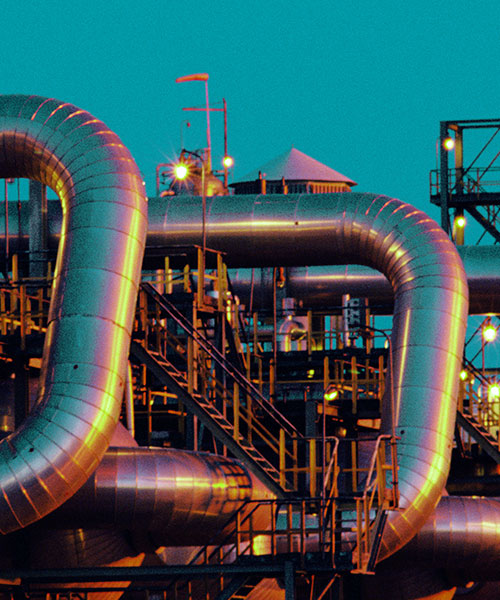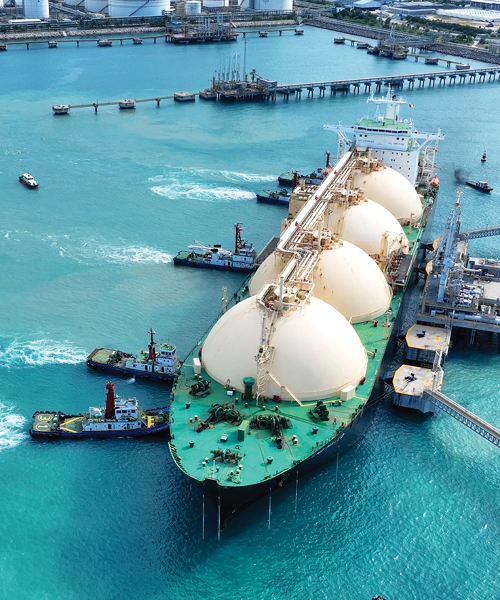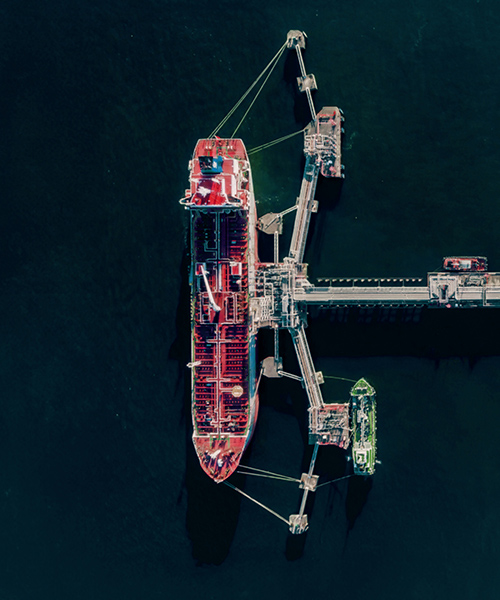6 min read
Decarbonizing LNG: how to measure and reduce carbon intensity
Not all natural gas is created equal, with carbon intensity measures set to determine the success of greenfield LNG infrastructure
“The question around LNG’s role in the energy transition is often oversimplified,” says Ashley Coaker, Vice President, Energy & Chemicals, Worley Consulting, EMEA. “LNG has an important role to play as a transition fuel for energy systems dominated by coal and oil, to lower carbon sources of energy. But that’s on the condition that we produce this natural gas with a sufficiently lower carbon intensity compared with current energy sources.”
Coaker appreciates the scale of the opportunity ahead, particularly for LNG producers that position to lead the global industry in sustainability performance. These projects can benefit GDP, mitigate climate change risks, and align with national socio-economic development visions for 2030 and 2050, which ultimately aim to improve living standards.
“However, LNG investors and consumers are looking for transparency on emissions and mitigation plans. And they’ll only support projects if new LNG infrastructure aligns with corporate net zero ambitions and climate risk management,” says Coaker.
“The carbon intensity of LNG also needs to align with the net zero ambitions of the host countries, and with the taxonomies of the countries where the natural gas is being sold to.
“So, there’s a lot riding on the carbon intensity of LNG infrastructure.”
Why carbon intensity is a crucial sustainability metric in the LNG industry
Coaker explains that the advantage of carbon intensity measures is that they address greenwashing concerns around producing, transporting, and using natural gas.
“Being able to get a true measure of sustainability performance – at every stage of the production and transport process – is useful to boost the social license of natural gas as a transition fuel.
“The foundation of this social license is a Life Cycle Assessment (LCA), covering cradle to grave for the LNG value chain. This includes emissions from the upstream assets, the LNG liquefaction facility, shipping and potentially end use.
“For greenfield developments – excluding end use combustion by the user – the major contributions to emissions are from compression power for refrigeration in liquefaction from methane emissions in upstream processing.
“Measuring and reporting on emissions intensity helps stakeholders understand how each cubic foot of natural gas stacks up against other forms of energy.”
While measuring carbon intensity across the entire LNG value chain can be challenging, having an accurate carbon intensity figure – and an accurate and achievable way to calculate it – can make a big difference.
For example, most LNG buyers will be countries who adopted the legally binding Paris Agreement and set ambitious national emissions reduction targets to reach net zero by 2050 or earlier or later. Certain countries in Asia have formally declared LNG as a ‘transition fuel’ until 2035, and under a new taxonomy requiring end-use emission technical screening criteria of 320g of CO2 equivalent (CO2e) per kilowatt-hour (320g CO2e KW/h) by 2025.
In the EU, the recent carbon border adjustment mechanism (CBAM) has been introduced for reporting the carbon emissions of imports. And financial adjustments will commence in 2026 with full implementation by 2034, which will impact the global LNG industry.
With these developments on the horizon, how can LNG producers – both current and aspiring – prove the carbon intensity of the LNG they produce?
“The LNG sector is grappling with the challenges of credibly reporting climate risks, complying with intricate greenhouse gas (GHG) methodologies, demonstrating carbon intensity reduction, and accurately benchmarking against industry peers and standards,” says Wrishi Sutradhar, Senior Vice President, Sustainability and Decarbonization Advisory.
“The solution is to view the LNG value chain in blocks and test the blocks against credible industry-accepted methodologies.
“We’re developing a comprehensive way to assess the LNG sector’s carbon intensity across the value chain. This solution will enable LNG producers, investors, and buyers to benchmark their performance internally and across industry. Complying with international standards, while identifying emissions-related risks and opportunities.”
Sutradhar and his team have brought together the leading GHG methodologies and different parties in the LNG ecosystem to determine Carbon Intensity (CI) of a sample of LNG plants on a well to delivery basis, using data from facilities all over the world. The CI calculations are done from production to regasification, block by block to give full visibility of CI across the value chain.
“This has been a complex and time consuming exercise, but it’s worth the effort to give full visibility across the value chain to prospective LNG customers, investors, and other stakeholders.
“These calculations can make or break the global competitiveness of LNG across the value chain. And the more operators we can engage with, the more this pool of data – and the value add from it – will continue to grow.”
Initiatives to reduce the emissions intensity of LNG facilities
The liquefaction value chain from wellhead to export flange can emit as high as 1 tonne of CO2 per tonne of LNG produced. These emissions result from the energy needed to purify and cool the natural gas to liquid form as well as any inherent CO2 emitted and fugitive losses.
However, Coaker and his team believe that to compete with industry leading facilities globally, a new LNG project should aim for 0.4 to 0.5 tonnes of CO2e per tonne of LNG produced, factoring in upstream, midstream and transportation to customers.
For greenfield LNG project developers, there are a range of options to reduce the carbon intensity of new liquefaction facilities and meet these targets, each with unique costs and benefits.
“One of the major initiatives new producers can explore is electrifying their greenfield liquefaction facilities,” says Coaker. “If producers can source a lower carbon power supply, such as from nearby renewable energy parks, these power generators could supply a moderately sized LNG facility.
“Or in situations where renewables are unavailable in sufficient quantities, then centralized, high efficiency combined cycle power generation plants or small modular reactors (SMRs) can supply both the LNG facility, other industries, and domestic users.
“For brownfield LNG facilities, electrifying existing infrastructure with lower carbon power supplies is the single largest opportunity for reducing the carbon intensity of a facility.”
Carbon capture, utilization and storage (CCUS) is also crucial technology to reduce carbon intensity.
“There are opportunities for post combustion CO2 capture for major combustion sources and any natural CO2 in the feed,” says Coaker. “If there is a mature or developed market in a location for CO2 sequestration, this can remove a large emissions quantity or, a CO2 export hub can be developed for sequestration by others.
“Other strategies include the use of well governed offsets to move carbon neutrality. As well as considering alternative fuels to reduce the carbon intensity of shipping LNG.
“It’s also important to consider methane emissions from upstream and midstream LNG operations, which have an even more potent warming effect than CO2,” continues Coaker.
“These methane leaks can happen because the tightness of all gas connections is difficult to guarantee. But producers can reduce the likelihood and severity of these emissions by electrifying equipment wherever possible, inspecting the sources and using methane detectors to visualize the leak locations and fix them.
“All of these initiatives impact the emissions intensity of LNG by the time it’s consumed. But the success of these investments depends on being able to measure the improvements and show them to customers, investors, and other stakeholders.”
The opportunity for emerging LNG producers
According to Coaker, with carbon intensity set to be a key differentiator in the LNG industry of the future, greenfield producers will be well positioned to compete on sustainability credentials.
“Decarbonization technologies such as renewable energy and carbon capture are always improving – and if carbon intensity plays a part in whether LNG is appealing in the market or not – new producers can invest in ultra-modern facilities. And with a circular and collaborative mindset, exceed the sustainability and revenue performance of brownfield facilities.
“That doesn’t mean brownfield infrastructure – often designed a decade or more ago – is destined to be stranded in an LNG market increasingly focused on carbon intensity,” continues Coaker. “There are avenues for significant decarbonization progress – for brownfield facilities – with the technologies we have today.
“What matters most, is that producers can prove their sustainability credentials to meet and exceed stringent carbon intensity goals from LNG consumers and facility investors.
“LNG is a transition fuel our global energy systems need while renewable technologies are rolled out globally. But only if it’s produced in more environmentally sustainable ways than alternative energy sources and has positive impacts on socio-economic development of the gas consumers and the project’s host country.”
Ready to drive your next project forward?






